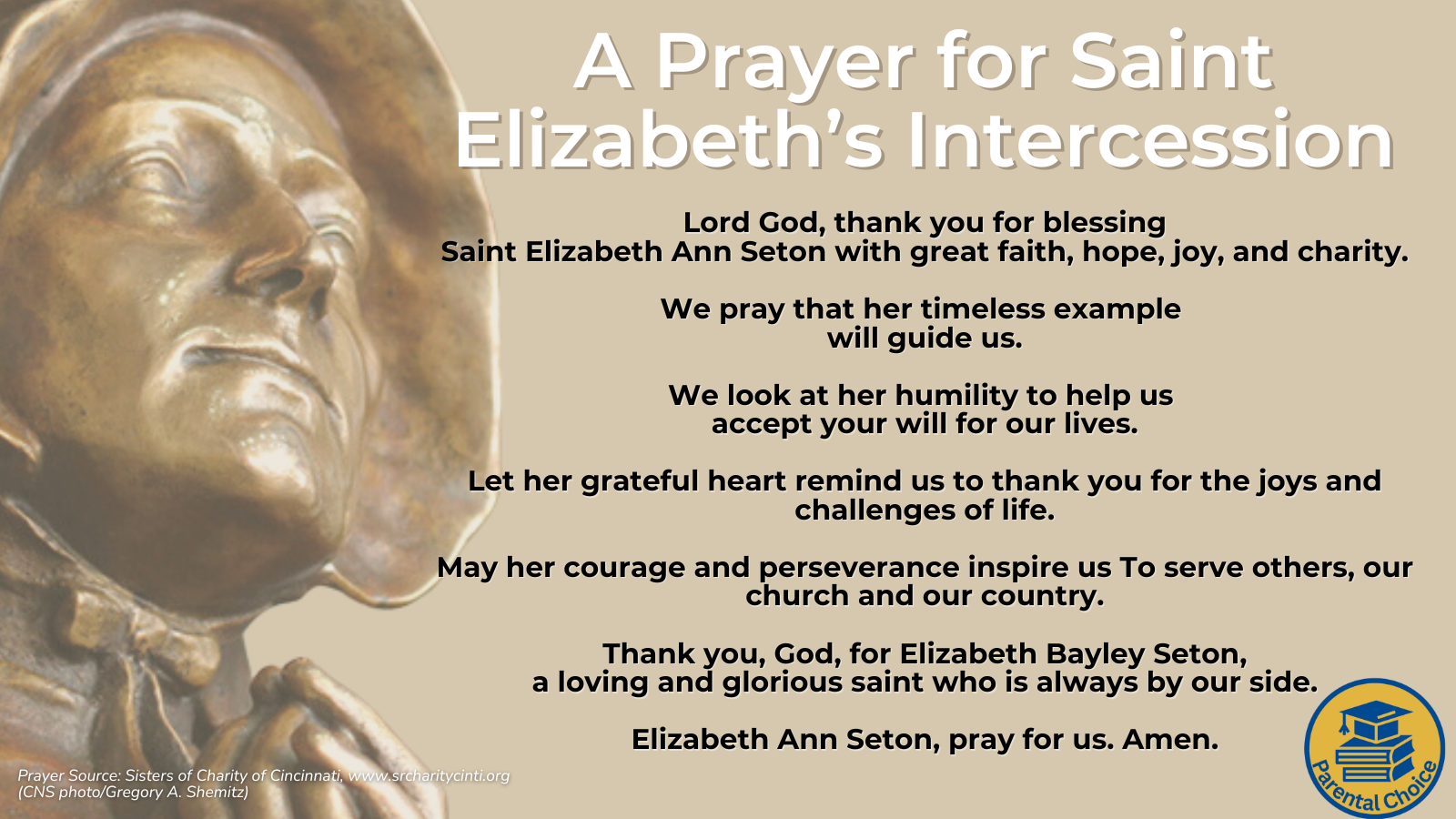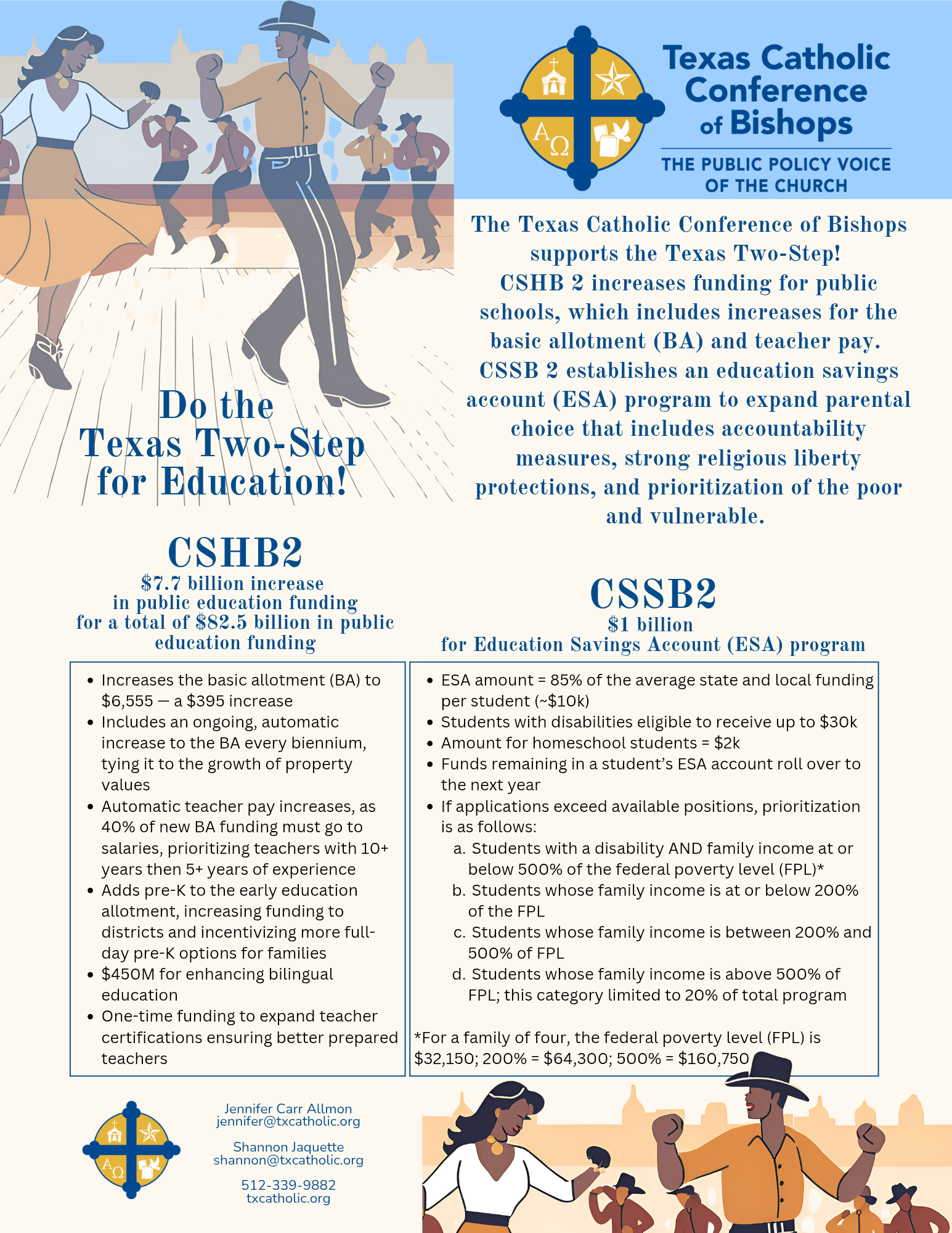Parental Choice in Education
The Texas bishops support parental choice! Learn more, then contact your legislator and let your voice be heard!

Glossary of terms

Parental choice facts
Parental choice does not funnel money from the public schools to private schools.
 FACT: In states with the oldest and largest educational choice policies, the inflation-adjusted per-pupil funding has increased, and the average performance of district schools is as good or better than when the choice policies were first enacted.
FACT: In states with the oldest and largest educational choice policies, the inflation-adjusted per-pupil funding has increased, and the average performance of district schools is as good or better than when the choice policies were first enacted.
 FACT: Most students will continue to benefit from a public-school education, because the many advantages offered by public schools, such as sports and other extra-curricular activities, are attractive to families. This is not a zero-sum game where private schools win, and public schools lose. It is a win-win for communities when all kids can flourish in the educational setting best suited for them.
FACT: Most students will continue to benefit from a public-school education, because the many advantages offered by public schools, such as sports and other extra-curricular activities, are attractive to families. This is not a zero-sum game where private schools win, and public schools lose. It is a win-win for communities when all kids can flourish in the educational setting best suited for them.
 FACT: School choice programs may slightly add to the fluctuation of student enrollment, but an overwhelming number of American families are still choosing schools based on ZIP Code.
FACT: School choice programs may slightly add to the fluctuation of student enrollment, but an overwhelming number of American families are still choosing schools based on ZIP Code.
We want taxpayer money to be given to families who can't afford private schools.
 FACT: The bishops support prioritizing the poor and vulnerable in any parental choice program. The bills we are supporting prioritize funding for students not currently enrolled in private schools.
FACT: The bishops support prioritizing the poor and vulnerable in any parental choice program. The bills we are supporting prioritize funding for students not currently enrolled in private schools.
 FACT: The wealthy currently benefit from school choice because they have the means to pay for private school or the means to move to live in the best public-school districts. The economically disadvantaged should have access to parental choice as well.
FACT: The wealthy currently benefit from school choice because they have the means to pay for private school or the means to move to live in the best public-school districts. The economically disadvantaged should have access to parental choice as well.
Parental choice can amplify transparency, accountability and oversight.
 FACT: The bishops only support parental choice policies that limit private school participation to accredited schools.
FACT: The bishops only support parental choice policies that limit private school participation to accredited schools.
 FACT: The private school accreditation process covers curriculum standards and fiscal oversight in a very responsible way. Accreditation requires that the curricula used in private schools be at least as rigorous as that used in public school, but there is flexibility in that choice.
FACT: The private school accreditation process covers curriculum standards and fiscal oversight in a very responsible way. Accreditation requires that the curricula used in private schools be at least as rigorous as that used in public school, but there is flexibility in that choice.
The future of parental choice programs depends upon their success, not a political agenda.
![]()
FACT: These programs will only expand if they are successful, and families demand more access. This means students are being well-served by having increased choice.
 FACT: 33 states have some form of educational choice. No state has ever repealed a program once they are established, because they are so effective and popular.
FACT: 33 states have some form of educational choice. No state has ever repealed a program once they are established, because they are so effective and popular.
Parental choice honors the separation of church and state.
![]()
FACT: The constitutionality of school choice programs has been proven many times, most recently in the Carson v. Makin case.
 FACT: When all parents are permitted to send their children to the school of their choice, this is not an endorsement of religion but the free exercise of a parent to choose their school.
FACT: When all parents are permitted to send their children to the school of their choice, this is not an endorsement of religion but the free exercise of a parent to choose their school.
 FACT: In the most recent ruling, Carson v. Makin, Maine’s “nonsectarian” requirement for otherwise generally available tuition assistance payments to parents who live in school districts that do not operate a secondary school of their own was found to violate the Free Exercise Clause of the First Amendment.
FACT: In the most recent ruling, Carson v. Makin, Maine’s “nonsectarian” requirement for otherwise generally available tuition assistance payments to parents who live in school districts that do not operate a secondary school of their own was found to violate the Free Exercise Clause of the First Amendment.
Parental choice improves the opportunities available to low-income families.
 FACT: Florida has the nation’s largest “school choice” program which enrolls largely low-income students from low-income schools. The average household income is $43,123 and 65% of program participants are Black and Hispanic. 43% of the children are from single parent households.
FACT: Florida has the nation’s largest “school choice” program which enrolls largely low-income students from low-income schools. The average household income is $43,123 and 65% of program participants are Black and Hispanic. 43% of the children are from single parent households.
 FACT: According to a study by the Urban Institute, 57% of Florida Tax Credit (FTC) scholarship students enrolled in college, compared with 51% of non-FTC students.
FACT: According to a study by the Urban Institute, 57% of Florida Tax Credit (FTC) scholarship students enrolled in college, compared with 51% of non-FTC students.
 FACT: FTC students had higher college-going rates in all sectors: two-year, four-year public, and four-year private colleges. Additionally, FTC participants were more likely to attend college full time.
FACT: FTC students had higher college-going rates in all sectors: two-year, four-year public, and four-year private colleges. Additionally, FTC participants were more likely to attend college full time.
 FACT: Average household income of recipients of the Illinois scholarship is $43,357.
FACT: Average household income of recipients of the Illinois scholarship is $43,357.
Parental choice will most likely impact rural schools the least.
![]()
